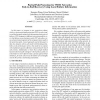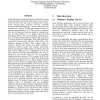155 search results - page 13 / 31 » A New Necessary Condition for Shortest Path Routing |
ICNP
2005
IEEE
14 years 2 months ago
2005
IEEE
Routing in mobile ad hoc networks remains as a challenging problem given the limited wireless bandwidth, users’ mobility and potentially large scale. Recently, there has been a ...
INFOCOM
2010
IEEE
13 years 6 months ago
2010
IEEE
Abstract—When forwarding packets in the Internet, Autonomous Systems (ASes) frequently choose the shortest path in their network to the next-hop AS in the BGP path, a strategy kn...
ISCC
2002
IEEE
14 years 1 months ago
2002
IEEE
In this paper, we propose a new protection scheme, which we term partial path protection (PPP), to select endto-end backup paths using local information about network failures. PP...
CCR
1998
13 years 8 months ago
1998
Bandwidth-sensitive multicast delivery controlled by routing criteria pertinent to the actual traffic flow is very costly in terms of router state and control overhead and it scal...
ICRA
2008
IEEE
14 years 2 months ago
2008
IEEE
— What is the shortest or fastest path a mobile robot can follow between two configurations in the unobstructed plane? The answer to this fundamental question is only known anal...


